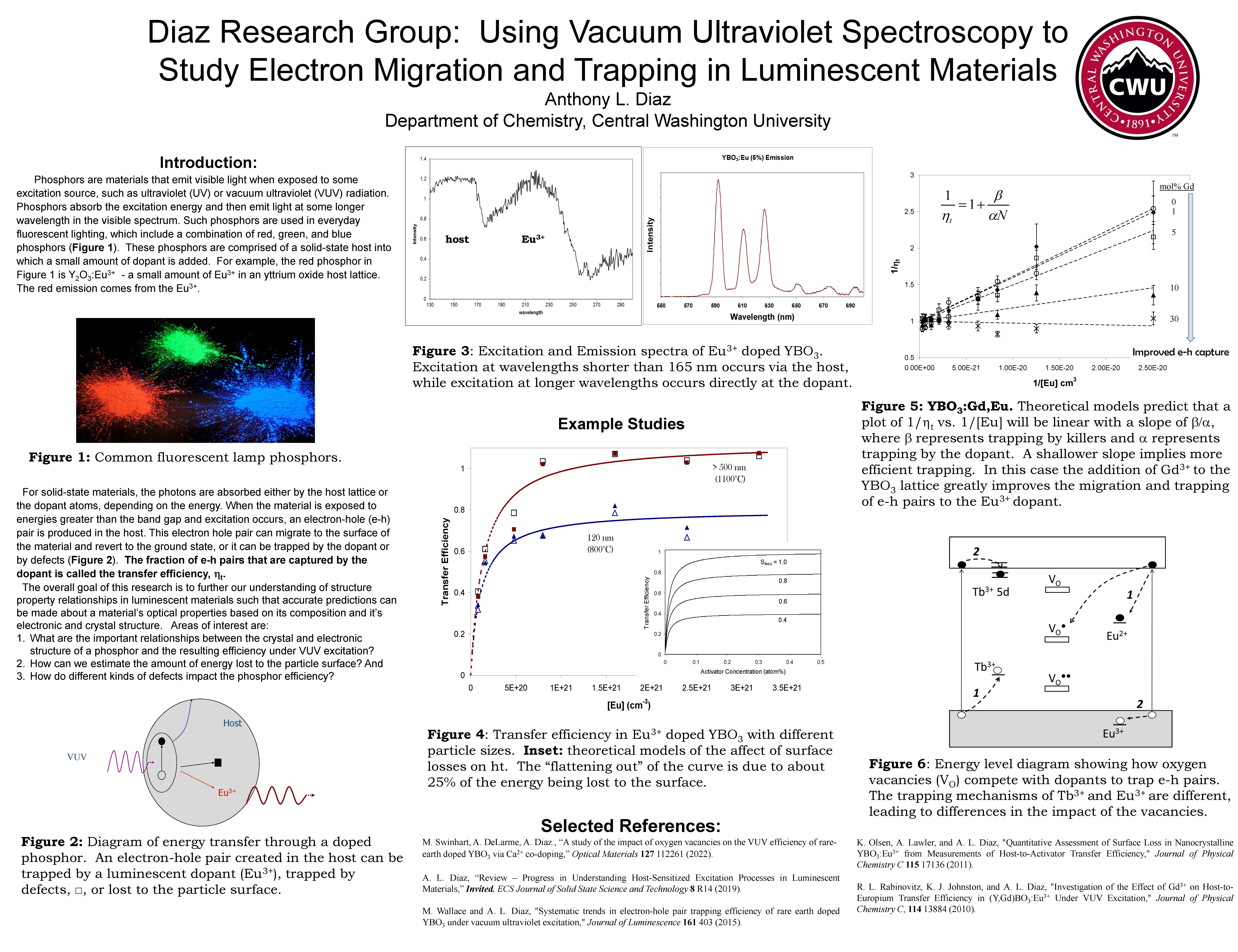Anthony Diaz
Professor, Inorganic Chemistry

Education
- 1996 - PhD, Oregon State University
- 1993 - MS, Western Washington University
- 1991 - BS, University of Washington
Research Interests
Dr. Diaz’s research involves the study of electron-hole (e-h) pair transport and trapping in doped luminescent materials under vacuum ultraviolet (VUV) excitation. Excitation by VUV radiation leads to the formation of an e-h pair in the host. In order for luminescence to occur this e-h pair must be trapped by the rare earth dopant. However, the electron may also be trapped by bulk killers (impurities or defects), or it may be lost to surface states. In this figure YBO3 is the host and Eu3+ is the dopant. The purpose of our research is to quantify the fate of the e-h pair after absorption of a VUV photon takes place.
Developing a detailed understanding of electron transport processes in solids is important to a wide variety of fields within materials science, including the study of scintillators, two-photon phosphors, dye-sensitized solar cells and transparent conductors. Functioning devices based on these technologies often require the transport of electrons through an oxide insulator. Although a fairly large number of useful materials have been developed for these applications, relatively little is known about the fundamental factors governing these processes. In particular, basic structure/property relationships for efficient VUV excitation are not well developed, and knowledge of such processes is inherently valuable to the study of electron transport in insulators in general.
Selected Publications
- M. Swinhart, A. DeLarme, A. L. Diaz, “A Study of the Impact of Oxygen Vacancies on the VUV Efficiency of Rare-Earth Doped YBO3 via Ca2+ Co-doping,” Optical Materials 127 112261 (2022).
- A. L. Diaz, “Review – Progress in Understanding Host-Sensitized Excitation Processes in Luminescent Materials,” Invited. ECS Journal of Solid State Science and Technology 8 R14 – R26 (2019).
- Z. Way, M. K. Wallace and A. L. Diaz, "VUV Optical Properties of Rare Earth Doped YPO4 Prepared by Different Routes," ECS Journal of Solid State Science and Technology 7 R3163-R3170 (2018).
- M. Wallace and A. L. Diaz, "Systematic Trends in Electron-Hole Pair Trapping Efficiency of Rare Earth Doped YBO3 Under Vacuum Ultraviolet Excitation," Journal of Luminescence 161 403 – 410 (2015).
- K. Olsen, A. Lawler, and A. L. Diaz, "Quantitative Assessment of Surface Loss in Nanocrystalline YBO3:Eu3+ from Measurements of Host-to-Activator Transfer Efficiency," Journal of Physical Chemistry C, 115 17136 – 17146 (2011). dx.doi.org/10.1021/jp202170u
- R. L. Rabinovitz, K. J. Johnston, and A. L. Diaz, "Investigation of the Effect of Gd3+ on Host-to-Europium Transfer Efficiency in (Y,Gd)BO3:Eu3+ Under VUV Excitation," Journal of Physical Chemistry C, 114 13884 – 13889 (2010).
- T. Watrous-Kelley, A. L. Diaz and T. A. Dang, "Quantitative Determination of Non-Radiative Host-to-Activator Energy Transfer Efficiencies in YBO3:Eu3+ and Y2O3:Eu3+ Under VUV Excitation", Chemistry of Materials, 18 3130 – 3136 (2006).
- B. Dawson, M. Ferguson, G. Marking and A. L. Diaz, “Mechanisms of VUV Damage in BaMgAl10O17:Eu2+”, Chemistry of Materials, 16 5311 – 5317 (2004).
- B. Howe and A. L. Diaz, “Characterization of Host Lattice Emission and Energy Transfer in BaMgAl10O17,” Journal of Luminescence, 109 51 – 59 (2004).
- V. Pike, S. Patraw, A. L. Diaz and B. G. DeBoer, “Defect Chemistry and VUV Optical Properties of the BaMgAl10O17:Eu2+ - Ba0.75Al11O17.25:Eu2+ Solid Solution,” Journal of Solid State Chemistry, 173 359 – 366 (2003).
Contact
Science Building 302B
